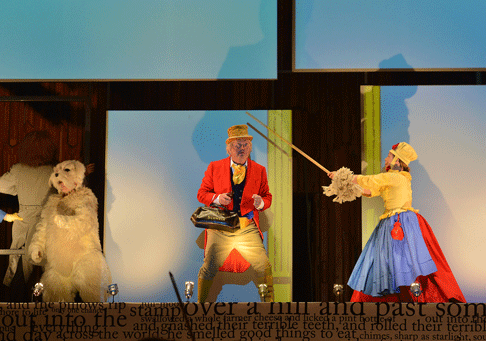This co-production of the two operas with the Aldeburgh Festival and
the Los Angeles Philharmonic Association was a delight. Netia Jones employs a
cunning, loving mix of animation and live action to retain as much as humanly
possible of Sendak’s celebrated drawings. Sometimes we see more of one than
the other, though the principal characters — the boy Max in Where the
Wild Things Are and Jennie the Sealyham Terrier in Higglety Pigglety
Pop! — are ‘real’ throughout. How much lies their — or our? —
imagination? What is real anyway? The use of animation for the monsters save at
the beginning and end of the first opera — we see the singers go behind a
screen and emerge at the end, and of course we hear the, throughout —
heightens our questioning. The screen in neatly reversed in Higglety
Pigglety Pop! so that we see the secondary characters both on stage and on
film. Again, what is real? Are not both varieties of apparition and/or
depiction? In the land of the Mother Goose World Theatre, all the world’s a
stage — a tribute, surely, as much to Stravinsky and his Rake’s
Progress tribute to Mozart, the latter parodied in Knussen’s final
scene, as to Ravel. (Both Higglety and Don Giovanni end
'outside' their dramas, in bright if tarnished D major.) The repetitions of
that gala performance, the time-honoured tradition of a play within a play,
unsettle as they should. What do they mean? When will they stop? Again, what,
and who, is ‘real’? That is very much the stuff of imaginary worlds,
strongest for some in childhood, but for many of us just as powerful in
subsequent stages of our lives.
Crucially, the sense of fantasy in libretto and production is at the very
least equally present in Knussen’s scores, kinship with Ravel especially
apparent in Where the Wild Things Are. And we all know who composed
the most perfect operatic depiction of childhood. Stravinsky sometimes seems
close too, for instance in the fiercer rhythmically driven music of the second
scene (Mama and her hoover), the Symphony in Three Movements coming to
my mind. And the musical material itself of course delightfully pays tribute
both to Debussy’s La boîte à joujoux and most memorably to
Boris Godunov, direct quotation reminiscing of the Tsar’s ill-fated
coronation when Max is crowned King of all Wild Things.
 A scene from Higglety Pigglety Pop!
A scene from Higglety Pigglety Pop!
Ryan Wigglesworth’s direction was palpably alive to this sense of
orchestral wonder and fantasy, his programme notes an exemplary tribute from
one composer-conductor to another from whom he has learned a great deal. The
tone of performance darkened in tandem with that of the score for Higglety
Pigglety Pop! Detail was meaningful without exaggeration, for instance in
the subtle pointing up of certain intervals associated with different
characters. Those with ears to hear would do so, consciously or otherwise.
Moreover, the orchestra’s response was as assured, as disciplined, as
generous as the conductor’s direction. The Britten Sinfonia was throughout on
outstanding form, thoroughly inside Knussen’s idiom, unfailingly precise
without sacrifice to warmth of tone. Despite relatively chamber-like forces, at
least in the string section (6.6.4.4.4), one often felt that was hearing a
larger orchestra, for this was anything but a small-scale performance. Indeed,
accustomed as I am to hearing the London Symphony Orchestra at the Barbican,
there were many times when I should not have been surprised to discover that I
had in fact been hearing the LSO.
Claire Booth headed a fine cast for Where the Wild Things Are, her
Max as quicksilver on stage as vocally. Lucy Schaufer proved every inch her
equal as Jennie in Higglety Pigglety Pop! Very much the singing
actress, her deeper mezzo tones were perfectly suited to the darkened tones of
the score. There is something a little dangerous about Jennie and the acting
world of ‘experience’ for which she forsakes her comfortable home — yet
in a sense all children must at some point act similarly. All members of the
two casts, however, were richly deserving of praise, a particular favourite of
mine Graeme Danby’s surreal, apparently innocent Pig-in-Sandwich-Boards.
These performances came across as true company efforts, a state of affairs
doubtless deepened by ‘experience’ in Aldeburgh and Los Angeles.
Mark Berry
Where the Wild Things Are
Max: Claire Booth; Mama/Voice of Tzippy: Susan Bickley; Moishe: Christopher
Lemmings; Emil: Graeme Broadbent; Aaron: Jonathan Gunthorpe; Bernard: Graeme
Danby; Tzippy: Charlotte McDougall
Higglety Pigglety Pop!
Jane: Lucy Schaufer; The Potted Plant/Baby: Susanna Andersson; Rhoda/Voice
of Baby’s Mother: Claire Booth; Cat-Milkman/High Voice of Ash Tree:
Christopher Lemmings; Pig-in-Sandwich-Boards: Graeme Danby; Lion/Low Voice of
Ash Tree: Graeme Broadbent
Netia Jones (director, designs); Britten Sinfonia/Ryan Wigglesworth
(conductor). Barbican Hall, Saturday 3 November 2012.

